



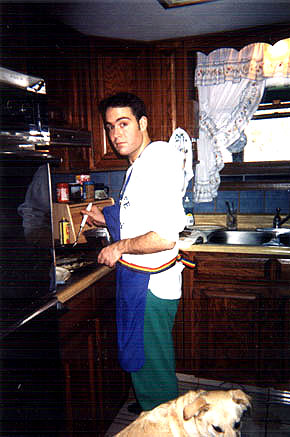 In my spare time, I like to cook, especially Central American, North African, Indian, Cajun, Thai and Jewish cuisines (Passover fans- please feel free to steal my recipes for chicken soup and kneidlach, latkes, matzah brei and charoset). I also like to read (about a book a fortnight, lest my brain turn to stew), brew beer, speed walk (yeah, it looks silly, but it's still cooler than jogging), play guitar, argue politics and religion, and listen to music. Lots of music. Perennial faves: Tom Waits, Nusrat Fateh Ali Khan, Rush (well, anything up to 1985 or so), Pink Floyd (especially from Meddle to Animals) Husker Du (and all things Bob Mould related), Genesis (the Peter Gabriel years - not that Phil Collins dreck), Henryk Górecki and Arvo Part.
In my spare time, I like to cook, especially Central American, North African, Indian, Cajun, Thai and Jewish cuisines (Passover fans- please feel free to steal my recipes for chicken soup and kneidlach, latkes, matzah brei and charoset). I also like to read (about a book a fortnight, lest my brain turn to stew), brew beer, speed walk (yeah, it looks silly, but it's still cooler than jogging), play guitar, argue politics and religion, and listen to music. Lots of music. Perennial faves: Tom Waits, Nusrat Fateh Ali Khan, Rush (well, anything up to 1985 or so), Pink Floyd (especially from Meddle to Animals) Husker Du (and all things Bob Mould related), Genesis (the Peter Gabriel years - not that Phil Collins dreck), Henryk Górecki and Arvo Part.
As you can probably see, I'm pretty heavily into music. Right now I'm back in my world music phase (as opposed to my Yes-Genesis-ELP art rock phase, my heavy metal phase, or my 20th century classical phase), especially since coming back from Turkey. I've been listening to numerous CDs of Anatolian folk music, including Turkish, Kurdish and Alevi music. My big fave is saz music - Anatolian music played on a long necked, 7-stringed banjo-like instrument. I love it so much I recently bought a saz and have been playing it daily. Now if I could only sing in Turkish and Kurdish fluently - or even sing at all, for that matter. Maybe if I get good I'll put some sounds files of me playing the saz online. Feel free to email your requests now....
Another big hobby of mine is genealogy. Right now I'm trying to track down info on my Dad's side of the family. Even though my last name is currently Carvin, in the Old Country (for me, that'd be Galicia - ie, modern-day southern Poland and Western Ukraine) our name was Karawan. Karawan, as it turns out, happens to mean 'pall bearer' in Polish, but according to what we've been able to dig up so far, the name originates from a much older and more obvious derivative: Caravan. So, our current thinking gives us two possibilities: either my family used to trade along the Persian caravan routes between Eastern Europe and southwest Asia; or, we came from the old Tunisian city of Qairawan, which had an enormous Jewish population in the Middle Ages. Take your pick. But my biggest lead so far has come in the form of the Yizkor book for the town of Busk (my family's home), now near Lviv, Ukraine. It's a memorial book for those Buskers who died in the Holocaust, written by Abraham Shayari of Haifa, Israel. Shayari, as it happens, is Hebrew for "caravan." The book contains an interesting history of Busk as well as an essay written by Georges Cleamenceau, who visited the town at the turn of the century. There are also several pictures of Busk rabbis - two of whom are named Karawan. Last but not least, the Yizkor list of names of the dead includes dozens of people named Karawan (spelled in Hebrew either as KRVN or KARAVVAN). It's exciting to have found this treasure trove of information, but admittedly, it's quite sobering to see how lucky my family was to go to America well before the slaughter began.
I'm also getting very interested in the role of DNA in genealogy. I'm currently taking part in a DNA study of Ashkenazic Jews, actually. Here's how it works: I donated a DNA sample (a swab from the inside of my cheek, just in case you were wondering) along with details of my families immigration history going back as far as I could. The researchers then did two things. First, they compared my DNA to known genetic markers for Cohanim - the ancient priestly class of Jews. Cohanim are traditionally believed to be direct descendants of Moses' brother Aaron. In recent DNA tests, many male Jews who had been told by their fathers that they descended from Cohanim actually shared a common ancestor dating back to the time of Aaron. According to the results of my test, I carry the Cohanim gene! In other words, I carry the set of genes that have been matched to an ancestor 100 generations back that is now believed to be the founding family line of ancient Jewish priests. So if you believe the history inferred from the science, I'm the great-grand nephew of Moses, 3000 years removed. Pretty wild stuff.
Second, the researchers examined looked for specific genetic markers in two elements of my DNA: my Y Chromosome (passed down from father to son) and my Mitochondrial DNA (passed down from mothers to her children). This way, they'll have a sense of two of my family lines: my father's father's line, and my mother's mother's line. This data will then be compared to other Jews in the study, with the hope of finding people who share a common ancestor. Over time, they hope to build a genetic family tree of Ashkenazic Jews. Already we've found seven exact matches for my Y chromosome DNA - seven other men in the study whose genetic markers matched mine. This means that all of us have an extremely high likelihood of sharing a common ancestor within the last 10 to 15 generations, give or take. And as it turns out, nearly all of us trace our families to the same region in Ukraine!
Even more amazing is the mitochondrial DNA test result -- according to a database of mtDNA samples around the world, my mtDNA is most similar to modern-day Nubians in northern Sudan! The mtDNA also matched with a few other samples from Bulgaria, Greece and the Middle East, but the biggest match was with the Nubians. So what does this mean? One of two things, I would guess. First, an ancestor of mine had a Nubian wife, slave or concubine. Israelites were of course in Egypt for many generations, alongside local Nubians. Israelite nobles also kept slaves, ironically, and there are reports of Israelite soldiers being banished to Nubia after being defeated by one of the Ptolemy pharaohs. Second, it's possible that my ancestors were always Jewish -- at least as long as there have been Jews. Mitochondrial DNA is very, very old, mutating every 10 or 20,000 years. This could mean that a group of Nubians migrated to the Middle East eons ago, then assimilated and became a part of the tribal groups that eventually became Jews. And since Hebrew and other Semitic languages have origins in northeast Africa, it raises this scenario as a possibility.
Needless to say, this is really exciting research -- so exciting that I was actually profiled in a January 2001 cover story for US News and World Report! I can't wait to see if there are more genetic matches as more people take part in the study.
Anyway, if you've ever encountered anyone with the last name Karawan, Karavan, Carawan, etc. (spelling used to be pretty pointless way back) who happens to be Jewish, or knows of anyone hailing from the small Ukranian city of Busk, please send them my way. I'd love to learn whatever I can from them. I'm also researching the following family names and places, if you have any suggestions or connections to them:
Mandel (Busk, Ukraine)
Bernhardt (Riga, Latvia)
Levinson (Russia)
Kaplan/Kaplanis (Kaunas, Lithuania)
Goldman (Kaunas, Lithuania)
Minsky (Kaunas, Lithuania, though Minsky means a person from Minsk, Belarus)
Last, but not least, I am making a feeble attempt to learn how to draw. Art has never been one of my strong points - in fact, my penmanship was (and is) so bad that my teachers encouraged me to use computers to communicate. Because I could barely draw a straight line I did my best to avoid any kind of sketching, but as I began to travel a lot I started to try to capture some of the great things I'd see along the way. So now that I've been able to warn you that I'm not good at this stuff, I can go ahead and share some of my works with a clear conscience:
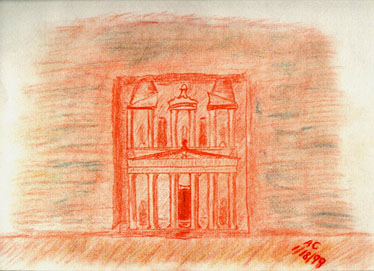 | El Khazneh, or the Treasury, Petra, Jordan. This 150-foot building is carved out of the living rock and stands as the entrance to this ancient Nabataean city. |
| Bodnath stupa, Kathmandu. This stupa, or Buddhist memorial, is the largest stupa in Nepal. It's surrounded by several Tibetan monasteries and a lively market. |  |
 | Angkor Wat, Cambodia. The temple of Angkor Wat is the largest religious structure in the world - larger than all of Vatican City. |
| La Rambla, Barcelona. La Rambla is perhaps the most beautiful boulevard in the world. I drew this on the last page of myBarcelona Rough Guide, which is why the top edge is torn. | 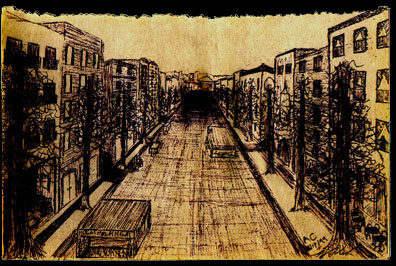 |
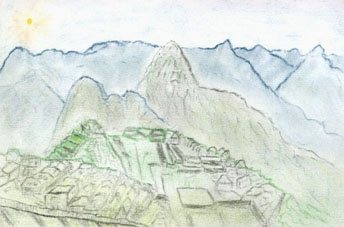 | Machu Picchu, Peru. For years I dreamed of seeing this image before me. It's more magical than I ever imagined. |
| The shore of Lake Titicaca, Copacabana, Bolivia. This peaceful resort village was a fascinating place to relax for a few days. | 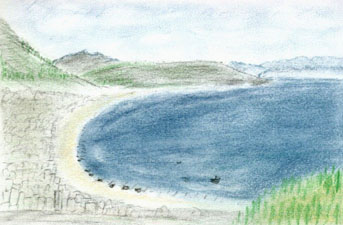 |

home | welcome | what's new | travels | projects | writings | diversions | trivia
Andy Carvin's Waste of Bandwidth. Copyright 1994-present by Andy Carvin (acarvin@benton.org). All Rights Reserved.